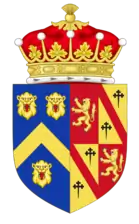Earl of Grantham was a title in the Peerage of England created once on 24 December 1698, along with the titles Viscount Boston, of Boston in the County of Lincoln, and Baron Alford, of Alford in the County of Lincoln, for Henry de Nassau d'Auverquerque. The titles were created with a special remainder, failing heirs male of his body, to his three brothers Cornelius, Maurice, and Francis, in like manner respectively.[1] Since both his sons and as well his three brothers had predeceased him, the titles became extinct upon his death in 1754.
Earls of Grantham (1698)

.svg.png.webp)




- Henry de Nassau d'Auverquerque, 1st Earl of Grantham (1675–1754)
- Henry, Viscount Boston (1697–1718)
- Thomas, Viscount Boston (1700–1730)
In fiction
Screenwriter Julian Fellowes used the title, Earl of Grantham — although as a fictional one and according to the storyline created in 1772 in the Peerage of Great Britain[3] — for one of the main characters, Robert Crawley, in his 2010 ITV1 period drama Downton Abbey. In this fictional setting, Viscount Downton was one of Crawley's subsidiary titles.[4][5]

Victor Hugo's 1869 novel The Man Who Laughs includes a reference to the Earl of Grantham and the Earl's Manor.[6]
See also
- Baron Grantham, created in the Peerage of Great Britain in 1761, merged with the title Earl de Grey from 1833 and extinct in 1923.
References
- ↑ "Grantham, Earl of (E, 1698 - 1754)". Archived from the original on 16 March 2012. Retrieved 21 October 2010.
- ↑ "European Heraldry, United Kingdom > Families > Families L to N > House of Nassau". European Heraldry. 2016. Retrieved 16 October 2016.
- ↑ "Press releases - Programme press releases - Downton Abbey - ITV Press Centre". Archived from the original on 29 October 2012.
- ↑ https://www.canberratimes.com.au/story/6382545/this-abbey-addition-is-impressive/ Downton Abbey review] - website of Australian daily newspaper The Canberra Times
- ↑ Everything you need to know about Downton Abbey before watching the movie - website of American magazin Entertainment Weekly
- ↑ The Man Who Laughs, Page 12